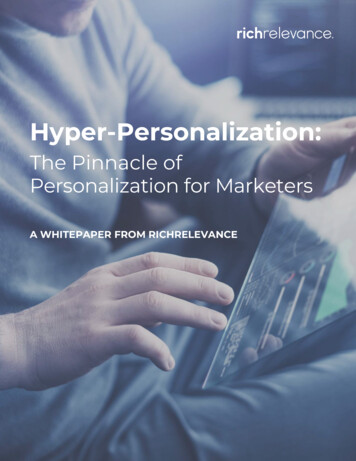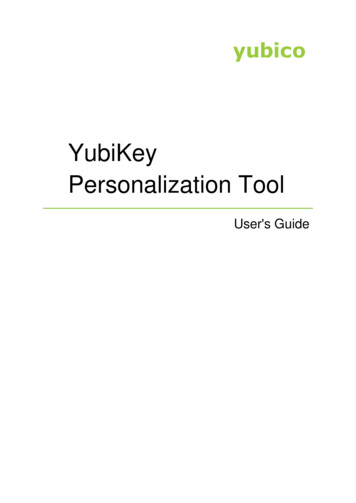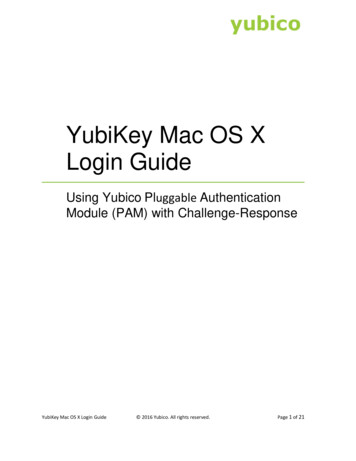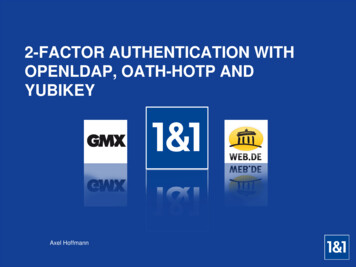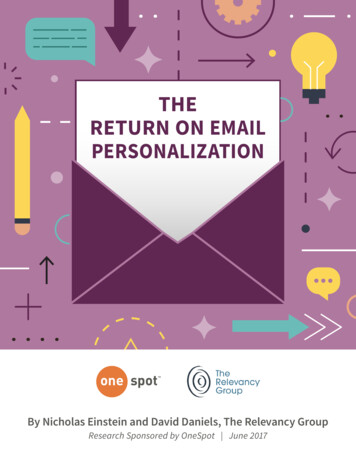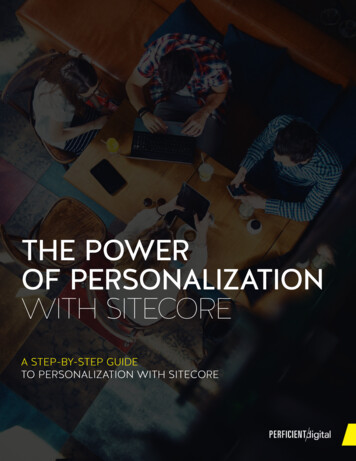
Transcription
THE POWEROF PERSONALIZATIONWITH SITECOREA STEP-BY-STEP GUIDETO PERSONALIZATION WITH SITECOREPERFICIENT DIGITAL
T H E P OW E R O FPersonalizationTargeting and personalization are consistently top-of-mind fordigital marketers. This is not without reason. By most industryestimates, advancing your user experience personalizationmaturity can result in a conservative 19% boost in conversion.1While personalization isn’t new to marketing strategy, it hasonly recently become the main focus of digital marketers.Content creation continues to be king, but marketers are nowtaking a closer look at how to make content more relevant andcustomized for individual targets. Web design, messaging, andcalls to action are now created with the individual customerexperience and the customer’s preferences and needsAccording to anEconsultancy poll,30% of marketerssay targeting andpersonalizationare their numberone priority.1in mind.1Gartner’s Magic Quadrant forWeb Content ManagementTechnology, however, can be a big barrierto a successful personalization strategy.According to a Demand Metric survey, 59%of marketers said they do not personalizecontent because they do not have theright technology to do so.2 There are manycustomer experience platforms (CXP) andbusiness solutions for personalization, butchoosing the correct technology for yourorganization depends on many factors,including your goals and strategy.This paper focuses on Sitecore Gartner’stop pick for enterprise level CXPs: Sitecore.Sitecore has received top ratings for itspersonalization and behavioral profilingabilities – a big focus for marketers when itcomes to their digital customer experiencesolution. Sitecore has evolved from its originas a content management platform (CMS) toits current version, Sitecore 8.2, which willbe used to illustrate the white paper.Perficient Digital
Prerequisites to PersonalizationPlan the StrategyTo reach to a mature level of personalization onWith all prerequisites in place, you can start to diveSitecore, there are some up-front requirements:into personalization. In Sitecore, personalization will Sitecore 8.0-8.2 (ideally 8.1 or above) CXP MongoDB to drive the Sitecore ExperienceDatabase (xDB) The technical bandwidth to handlelarge workloads be driven by both explicit and implicit behavior. Outof the box, you have the ability to build a uniquecustomer journey through both rules and behaviorbased personalization. Keep in mind that you will wantto properly plan and document the personalizationstrategy, from a high-level strategic standpointA solution like Habitat/Helix or Sitecoreto a detailed tracking of content, as it relates toIgnition to provide a component-basedpersonalization. It is best to start simple. What mayauthoring environmenthave already been a long process to get contentTop-down company buy-in for an enterpriseclass solution and the team to support itcreated for a single page will grow exponentially asyou build an ever-evolving set of unique, rule-driven,content-filled components.Start with StrategyMarketer PreparationsTo drive personalization in Sitecore, you first need toExplicit Behaviorbuild a strategy. This will pay off in the long run. Asis demonstrated when visitors take action or submitwith other solutions, you need to provide the CXPdata, such as voting in a poll, searching for a specificwith the nuts and bolts to drive the experience.keyword, or filling out a form.The good news is that with Sitecore you do not haveto tag every page with a line of code, because it isbuilt from the ground up as one cohesive solutionthat contains your content, marketing, and analytics.There are some high-level strategic elements that allRule-based personalizationFilling out a formMaking a purchaseFavorite-ing an itemstakeholders should discuss and put into place:1.Goals that act as triggers based on users hitting apage or a specific action (such as a button click)2.Engagement value scoring that improves analyticsby driving reporting that is relevant to your businessand can further drive personalization3.Campaigns that tie multi-channel (on- and off-line)activity to user activity over sessions on your siteand back to the campaign4.Marketing taxonomy that, simply put, is a set of tagsthat you can define and apply to goals, campaigns,assets, and so on. These also provide deeper insightin Sitecore Analytics and can drive personalization.Implicit Behavioris demonstrated when a visitor looks at a particulartype of page or follows a particular site path.Predictive personalizationBrowsing activityTypes of pages/categoriesPattern matchesPerficient Digital
Rules-Based PersonalizationSetupBuilding rules-based personalization requires some sort of driver to build the rule. For this, you will want topull from the high-level strategic elements mentioned earlier. A quick win for personalization is using a goal,combination of goals, or a campaign to define what content is delivered to the user in a component. With propersetup, these components, or sections of your web page, will be individual elements that can be individuallypersonalized. This allows for deeper personalization control of each page.There are three main ways to personalize a component:1. Change the contentin the component2. Swap componenttype and function3. Hide the componentfrom viewIs demonstrated when visitorsChange out one type ofAs the name suggests, choosetake action or submit data, suchcomponent for another. Forto hide an entire componentas voting in a poll, searching forexample, use a “form” or “poll”from view.a specific keyword, or filling outinstead of a column of copy,a form.or an “image and text”component instead ofa “text only” component.Using the Experience Editor, use the [VIEW] tab to turn on the navigationbar and move quickly through site pages. Also, pay attention to editor anddesigner modes. It’s best to only have one on at a time, especially as youget comfortable with using the editor.Perficient Digital
How to Setup Rules-Based Personalization of aComponent in the Sitecore Experience Editor1 Inside the Experience Editor, click on a component to select and activate the component2 The default view cannot be deleted or moved. By clicking on the [ ] in the upper righttoolbar and click the personalization icon.corner, you can stack a different personalization layer on top. {Note: You can stack multiplepersonalization layers and the Sitecore rules engine will analyze the rules from the top down,taking the version that first matches its rule. If no rules match, the bottom “Default” layerwill be shown.)Perficient Digital
3 Name the new personalization layer for easy reference.4From here, you could simply start to change content, but note the slider in the upper leftwhich allows you to change the component. Move the slider to reveal the component“Presentation” dialog.Perficient Digital
5You can now either select the [ . ] button for the component, which will allow you6.Select an existing content item from the available content. (Content can be pre-created,to select a component that is an approved replacement, or .cloned, created from scratch, etc.)Perficient Digital
7With the new content and/or component set up, click “Edit Rule” to view Sitecore’spowerful Rule Editor (many out-of-the-box rules are available, but this can be customizedto fit your business).8Use the search bar to quickly access a rule like Goal or Campaign, and it will pull uprelevant rules.Perficient Digital
9Build the rule by first clicking on the yellow text and then selecting (in this case) Punctuation:a goal. (You can create complex rules by adding more than one and using and/or phrases.)Finally, review your goal.10Click OK and review your personalization stack. Note the percentages on the right-handside. These values will react based upon which rules are triggered by different users forquick reference.Perficient Digital
1112Click OK and view the personalization in-line on the page by clicking on thedrop-down menu.Save and Smart Publish.Perficient Digital
How to Setup Behavioral PersonalizationDive deeper into personalization by continually tracking implicit user behavior. To do so, you need to takethe personas you have, understand how they relate to content on pages, fill any content gaps, define theattributes that make up your personas, and ultimately recognize user patterns as they relate to your businessand product(s).Let’s walk through the mechanics of setting up a persona-based profile.1In the Marketing Control Panel, click on the Profiles folder in the tree.Perficient Digital
2Click the Profile button under the Options tab, or right-click on the Profiles folder to create3Once created, fine tune two settings in the Data section: Type and Decay Rate.4Right-click on the new profile and create your keys. These keys should be attributes that makeyour Persona Profile. Give it a unique name and save.up the Persona Profile Cards you will create next, and will be common across Profile and PatternCards. The name will auto-fill. Simply add a Max Value of 10 and save. Repeat for all keys.Perficient Digital
5Click once on the Profile Cards folder, and then Data to define Authoring Selection (covered6With the keys created, next create your first Persona Profile Card. Note there is also a non-in detail in the “Type” post indicated above).Persona profile card, and the main difference is that the Persona version allows you to add moredetail around the Persona. Whether you choose a non-Persona or a Persona profile, setting upthe “keys” is a common and critical to a functioning Profile Card. Right-click on the Profile Cardsfolder to create.7Fill in as much detail about your persona as you and your team feel is important to the contentauthors/editors. They will be able to reference this information in the Experience Editor byhovering over the profile. A picture can provide a quick visual reference.Perficient Digital
8IMPORTANT: Under Profile Card Value, use the sliders to apply the amount of each key thatapplies to this specific Persona Profile. This defines the pattern that will be picked up on thepage visit.9Save.10Repeat for each Persona Profile Card.11Once all of your Persona Profile Cards have been created, select the top (main Profile) folderthat contains all of your new keys, Profile Cards, and Pattern Cards folders. Then, Smart Publish(make sure that “Publish sub items” is selected). Once complete, they will be available for use.12You now need to apply your Profile Cards to pages. To start, apply them to key decision pages,13In the Experience Editor under the Optimization tab, you will see a box on the far-rightlanding pages, and pages with content that helps drive focus on a specific profile.side where you apply these profiles to your page. If you don’t see it, scroll the ribbonuntil you do.14Click the blue “Associate Profile Card” to apply your new Persona-Profile Card(s)to the page.Perficient Digital
15In the Profile Cards dialog, you will be able to select from the different types of Profilecards. For now, let’s focus on the unique Persona group you created by clicking theEdit button.16Your profile card will appear on the left. Click the Personas that are relative to the content on thispage and define percentages. If your math does not equal 100%, Sitecore will alert you. Onceyou have one or more Personas and percentages set, you will see the pattern that your users willinherit by landing on this page. It is important to note that once you have cards set up on manypages, this pattern will be ever-evolving during the session and even across multiple sessions.17There is an option to create a custom pattern, and this option can be disabled per user/role. It is18Once defined, click OK, review your settings, and click OK again.19You will see the patterns or images in the upper right corner of the ribbon.recommended that unless you are an admin, have your development partner turn this off.Save the page and publish.Perficient Digital
2021Repeat for other pages.Let your Profile Cards “run” for 3-6 months to get a feel for what patterns develop and how usersexplore your site, how they convert, etc. Look for patterns that relate to your business. Then, inthe Marketing Control Panel, right-click on Pattern Cards and create a Pattern Card.22Name the card as it relates to your business and - just like the Profile cards - determine how thecommon keys are set using the sliders.Perficient Digital
23From here, you will apply the patterns to components. This is simply a rules-based24Navigate to the page and component you wish to personalize. Choose the personalizationpersonalization setup from this point.icon in the component toolbar and add your personalization layer.25Choose the Content, Component, or Hide methods and finish your selections as you would in26Edit the rule and type “pattern” in the search tool to pull up pattern options.rule-based personalization.Perficient Digital
27Add the pattern rule of choice, select the profile and pattern that maps to the content andthen review.28Repeat for other components, but keep it simple to start (hero banners, CTAs, etc.).29Save and publish the page.With all items properly saved and published,Out of the box – with the ability to combineas users traverse your site they will pickgoals, campaigns, and behavior – Sitecoreup Profile Card patterns based on what isgives you the tools to create complexdefined on the page. Sitecore will “listen” forpersonalization scenarios and drive yourthese patterns and serve up component-levelcustomers to conversion. With a keep-it-content based on the pattern it “hears” whensimple model that evolves over time, you andthe page is rendered. This can change overyour team can carefully define content andtime and can be grouped with other rules-user journeys that will conservatively leadbased goals.to a 19% improvement on key performanceindicators.Perficient Digital
Mastering customer experience provides the competitive edge for today’s organizations.As more companies lead the way in personalization, this will continue to raise the bar forconsumers’ expectations.And personalization goes beyond knowing who your customers are – they want to see thevalue in the experiences your company provides, based upon your knowledge of them.With a more holistic view of your customers that’s backed by a solid technology platformlike Sitecore, you can create, test, and optimize experiences to keep them coming back formore. Then, partner with an experienced team like Perficient Digital that will not only help youimplement the solution, but also create a strategy to align people and processes to embrace it.References1 “The Realities of Online Personalization” Econsultancy.com Ltd., April 2013.2 nalization-benchmark-reportAbout the AuthorRick BauerSenior Technical Consultant and Sitecore Digital Strategy MVP, PerficientRick provides insight, training, and a passion that maximizes the potentialof the Sitecore Customer Experience Platform. He utilizes his years ofhands-on Sitecore experience and certifications to help deliver clearsolutions and actionable results for marketers – those either new to theplatform or those looking to take it to the next level of maturity.Perficient Digital
Perficient Digital and Sitecore combine the innovation andimagination of a digital agency with the strategic insightsand technical capabilities of our Sitecore platinum implementation specialists.Driven by customer insights, we gather and analyze the data to design, architect,and implement websites built on the Sitecore platform. Our experts craft anexperience that tells a story and enables you to connect with consumers wherethey are – across mobile, tablets, and desktops. And, with a deep understandingof business needs and extensive technical capabilities, we can integrate solutionsacross a wide variety of applications, providing a seamless customer experience.Our full-service offering is designed to tackle your ever-changing, ever-increasingbusiness challenges. End-to-end is just the icientPerficient Digital
Sitecore has received top ratings for its personalization and behavioral profiling abilities - a big focus for marketers when it comes to their digital customer experience solution. Sitecore has evolved from its origin as a content management platform (CMS) to its current version, Sitecore 8.2, which will be used to illustrate the white paper.


